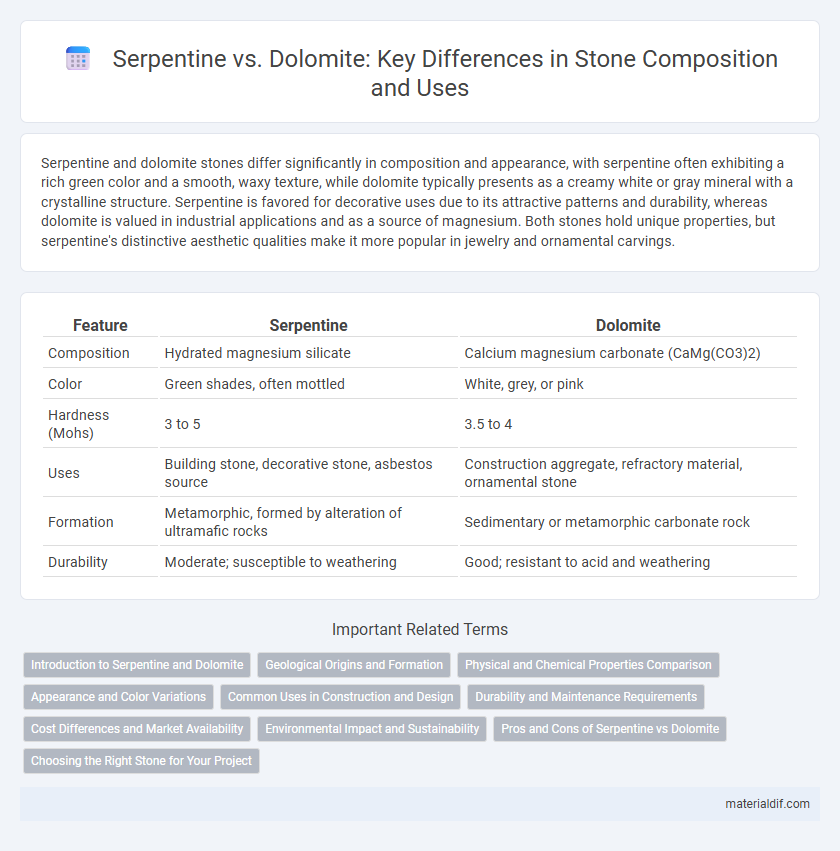Serpentine and dolomite stones differ significantly in composition and appearance, with serpentine often exhibiting a rich green color and a smooth, waxy texture, while dolomite typically presents as a creamy white or gray mineral with a crystalline structure. Serpentine is favored for decorative uses due to its attractive patterns and durability, whereas dolomite is valued in industrial applications and as a source of magnesium. Both stones hold unique properties, but serpentine's distinctive aesthetic qualities make it more popular in jewelry and ornamental carvings.
Table of Comparison
| Feature | Serpentine | Dolomite |
|---|---|---|
| Composition | Hydrated magnesium silicate | Calcium magnesium carbonate (CaMg(CO3)2) |
| Color | Green shades, often mottled | White, grey, or pink |
| Hardness (Mohs) | 3 to 5 | 3.5 to 4 |
| Uses | Building stone, decorative stone, asbestos source | Construction aggregate, refractory material, ornamental stone |
| Formation | Metamorphic, formed by alteration of ultramafic rocks | Sedimentary or metamorphic carbonate rock |
| Durability | Moderate; susceptible to weathering | Good; resistant to acid and weathering |
Introduction to Serpentine and Dolomite
Serpentine is a group of greenish, metamorphic minerals often used as decorative stones and for architectural purposes due to their attractive patterns and durability. Dolomite, a sedimentary carbonate rock composed primarily of the mineral dolomite, is valued in construction and industrial applications for its hardness and chemical stability. Both stones vary in texture and composition, influencing their suitability for specific uses in design, landscaping, and manufacturing.
Geological Origins and Formation
Serpentine forms through the hydration and metamorphic transformation of ultramafic rocks, primarily peridotite, within the Earth's mantle, characterized by a distinctive green color and smooth, waxy texture. Dolomite originates as a sedimentary carbonate mineral formed by the diagenetic alteration of limestone through magnesium-rich fluids, resulting in a crystalline structure with a typically light gray to pink hue. These differences in geological origins highlight serpentine's mantle-derived ultramafic metamorphism versus dolomite's sedimentary and chemical replacement processes in shallow marine environments.
Physical and Chemical Properties Comparison
Serpentine is a metamorphic rock primarily composed of magnesium silicate minerals, characterized by a greenish hue, a greasy or waxy luster, and a relatively low hardness of 3 to 6 on the Mohs scale. Dolomite is a sedimentary carbonate rock consisting mainly of the mineral dolomite (calcium magnesium carbonate), exhibiting a light to dark brown color, a crystalline texture, and a hardness of 3.5 to 4. Chemically, serpentine has a formula of Mg3Si2O5(OH)4, making it rich in magnesium and water content, whereas dolomite's CaMg(CO3)2 composition results in carbonate presence and reactivity to dilute acids with effervescence.
Appearance and Color Variations
Serpentine exhibits a rich palette of green shades, ranging from deep emerald to olive and yellow-green, often featuring a waxy or silky luster that enhances its visual appeal. Dolomite typically presents in softer, more muted tones such as creamy white, light pink, and gray, with a crystalline texture that can appear pearly or glassy. The distinct color variations and surface finishes of serpentine and dolomite make them easily distinguishable in architectural and decorative stone applications.
Common Uses in Construction and Design
Serpentine is often used for decorative architectural elements such as tiles, countertops, and ornamental stone due to its attractive green hues and ability to take a high polish. Dolomite, valued for its hardness and durability, is commonly employed as a dimension stone in flooring, wall cladding, and aggregate in concrete production. Both stones contribute to sustainable construction practices, but serpentine's aesthetic appeal contrasts with dolomite's structural functionality in building design.
Durability and Maintenance Requirements
Serpentine offers moderate durability but is more susceptible to scratches and etching compared to dolomite, which provides higher resistance to wear and chemical damage. Dolomite requires less maintenance due to its denser structure that repels stains and minimizes surface degradation over time. Choosing dolomite ensures a longer-lasting stone surface with fewer upkeep demands, ideal for high-traffic or demanding environments.
Cost Differences and Market Availability
Serpentine generally costs less than dolomite due to its more abundant natural deposits and easier quarrying processes. Dolomite, valued for its higher hardness and chemical stability, commands premium prices and is less readily available in some regions, impacting market supply. These cost differences influence their use in construction, landscaping, and industrial applications where budget and material properties are critical factors.
Environmental Impact and Sustainability
Serpentine, a naturally occurring mineral often used as a dimension stone, has a lower carbon footprint due to its ability to capture and store carbon dioxide through mineral carbonation. Dolomite, a carbonate rock primarily composed of calcium magnesium carbonate, requires more energy-intensive quarrying and processing methods, which contribute to higher greenhouse gas emissions. The sustainability advantage of serpentine lies in its potential for carbon sequestration, making it a more environmentally responsible choice compared to dolomite in construction and landscaping applications.
Pros and Cons of Serpentine vs Dolomite
Serpentine offers excellent resistance to heat and corrosion, making it ideal for architectural applications, but it is softer and more prone to scratching compared to dolomite. Dolomite is highly durable and abrasion-resistant, often used in construction and road materials, yet it can be more susceptible to acid rain due to its carbonate content. Choosing between serpentine and dolomite depends on the specific needs for strength, weather resistance, and aesthetic qualities in stone selection.
Choosing the Right Stone for Your Project
Serpentine offers a rich green color and a unique, smooth texture, making it ideal for decorative applications where aesthetic appeal is paramount, while dolomite provides superior durability and resistance to weathering, suitable for structural projects requiring longevity. The choice between serpentine and dolomite depends on project needs such as visual impact, hardness, and environmental exposure. Evaluating factors like compressive strength, porosity, and maintenance requirements ensures selecting the optimal stone that balances functionality and design.
Serpentine vs Dolomite Infographic

 materialdif.com
materialdif.com